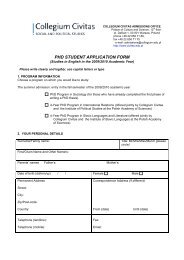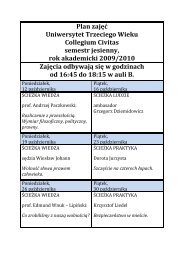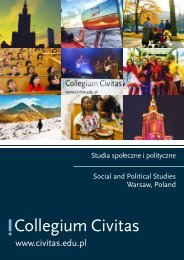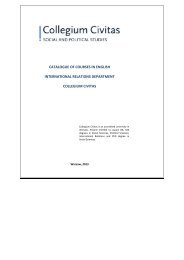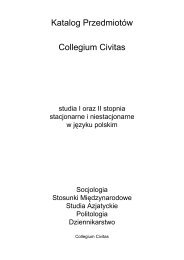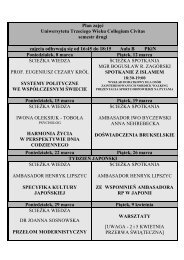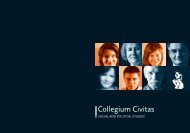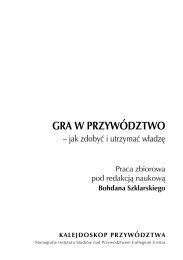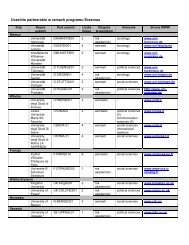Student essay submitted by Laura Robertson
Student essay submitted by Laura Robertson
Student essay submitted by Laura Robertson
You also want an ePaper? Increase the reach of your titles
YUMPU automatically turns print PDFs into web optimized ePapers that Google loves.
1<strong>Laura</strong> <strong>Robertson</strong>Table of Content1. Introduction ................................................................................................................ 22. Responses to the Auschwitz-Birkenau Museum........................................................ 23. Barriers to engaging with Holocaust memorial Sites ................................................ 83.1 Ice-cream at Auschwitz........................................................................................ 83.2 Information Overload........................................................................................... 93.3 Auschwitz on film .............................................................................................. 124. Remedies to these barriers ....................................................................................... 135. Conclusion ............................................................................................................... 17
21. IntroductionIn a scene echoing Tadeusz Rozewicz’s short story An Excursion to a Museum 1 , a young family standcrowded together, arms around each other. The children look laughingly at the camera. Their fatherasks them to move a little closer together and then clicks the shutter. Above their heads, the words‘Arbeit Macht Frei’. And therewith forms the question in my head, “is that appropriate here, in thisterrible place?” It is universally accepted <strong>by</strong> the majority that Holocaust memorial sites must betreated with respect, but problematically we are not united in our opinion of what constitutesrespectful behaviour and what does not; what honours the memory of the dead and what defamesit. Using Rozewicz’s short story as a framework, this <strong>essay</strong> will aim to outline various visitor responsesto Auschwitz and seek to analyse how we judge the appropriateness of these responses and, indeed,who has the right to make these judgements. It will also aim to identify potential barriers to fullyengaging with the site. In conclusion I will aim to draw some meaningful conclusions as to how thesebarriers could potentially be overcome in order to allow each visitor to engage with the Auschwitz-Birkenau site as fully as possible.2. Responses to the Auschwitz-Birkenau MuseumIt is undeniable that the Auschwitz-Birkenau Museum is a powerful place with the ability to evokestrong emotions in visitors; fear, shock, sadness, empathy, anger amongst others. However, visitors1 “A teen-aged boy in tight pants is standing next to a sign that reads ‘Halt!’ His buddy is taking a picture.”Rozewicz, Tadeusz. (2002), An Excursion to a Museum, in: A Dream <strong>by</strong> Felicja Kruszewska (Routledge).(Available at http://www.aapjstudies.org/manager/external/ckfinder/userfiles/files/Rozewicz.pdf [Accessed 13Feb 2013]), p6.
3exhibit a wide range of emotions, some of which would not typically be associated with a visit to aHolocaust memorial site; for example, disappointment. Auschwitz is perhaps a particular case in thisinstance as it is unrivalled as the best known and most widely portrayed of all Nazi concentrationcamps. Sometimes, having seen the former concentration camp immortalised countless times on filmand in books, visitors are somewhat disappointed <strong>by</strong> what Fackenheim refers to as the “ presence ofan absence” 2 that they find inside the camp gates- whether it be the absence of emotions they feelor the absence of victims themselves. Indeed, Professor Elwira Grossman of Glasgow Universityconcurs that “ it is paradoxically what’s not there that continues to fuel visitor’s curiosity in 1949 asmuch as it continues to do in 2004”. 3 How are we then to deal with this “absence”? In An Excursionto a Museum, a child comments:“Mommy, there’s nothing here. What kind of a museum is this, anyway?’ 4Traditionally museums are places where we go to look at what has been left behind, but in Auschwitzwe go to look at those who are no longer there.In other cases, fear, anger and sadness can manifest themselves in behaviour that may be consideredoffensive <strong>by</strong> some. Particularly younger visitors may talk loudly, joke, push and shove. In many casesthis boisterous behaviour can act as a shield against unexpected or unwanted emotions. In other2 Fackenheim, Emil in Camper, F. ( 1987), Shoah’s Absence, in: Motion Picture 4. ( Available athttp://www.fredcamper. com/Film/Lanzmann.html> [Accessed 13 Feb 2013]).3 Grossman, Elwira M. (2008), Auschwitz: a never-ending story, in: Scottish Review of Books, 4(1). (Availableat http://www.scottishreviewofbooks.org/index.php/back-issues/volume-four/volume-four-issue-one/107-auschwitz-a-neverending-story-elwira-m-grossman [Accessed 17 Feb 2013]).4 Rozewicz, Tadeusz. (2002), An Excursion to a Museum, in: A Dream <strong>by</strong> Felicja Kruszewska (Routledge).(Available at http://www.aapjstudies.org/manager/external/ckfinder/userfiles/files/Rozewicz.pdf [Accessed 13Feb 2013]), p2.
4cases, visitors are simply not sufficiently prepared for what it means to visit a memorial site and whatbehaviour is expected of them.A further reaction sometimes experienced is that of no reaction at all. This is perhaps the hardest ofall to deal with; having come to the camp full of trepidation and expectations, visitors find that theyfeel nothing. Coupled with the personal disappointment, there may also be feelings of guilt:“How could I be in Auschwitz and feel nothing: is it disrespectful, is it hideously indifferent, is theresomething wrong with me?” 5Furthermore, people may exhibit behaviour that other visitors may find inappropriate. InSachsenhausen concentration camp I witnessed a young man posing for a photo on the campgallows, imitating a hanged man. In that moment, I was certain that some acts are definitivelyinappropriate. On this spot where hundreds of people had their lives taken from them, no oneshould be emulating the tragedy for a photo. In contrast to the family photo mentioned above, I findthe motivation behind the acts important when trying to judge their appropriateness. In the firstinstance, perhaps the family wish to immortalise their visit to the museum, so that it will not beforgotten. For them this may be a commemorative act. I, personally, still find photographing one’sfamily in such a location problematic. Author Anne Karpf indicates a similar feeling:5 Polish Ministry of Education, Auschwitz-Birkenau State Museumand Council of Europe. (2010), Editors: Alicja Białecka, Krystyna Oleksy, Fabienne Regard and Piotr Trojan´ski,European pack for visiting Auschwitz-Birkenau Memorial and Museum, (Council of Europe Publishing:Strasbourg), p30.
5“ I can't believe the other tourists are photographing each other smiling on the ramp- but perhapsthis is the only way they can deal with it all, <strong>by</strong> trying to contain it within an ordinary touristicexperience.” 6However, such an act is not necessarily inappropriate. Indeed, visitors are permitted to takephotographs throughout the Auschwitz-Birnkenau museum. Photography is a powerfulcommemorative tool and may act as a vehicle for visitors to engage with the site, however, it shouldbe used carefully and thoughtfully.If Auschwitz then is not to be treated like just another mass tourist site, then how are we to act?Dubbed “dark tourism” 7 , this branch of sightseeing involves moral considerations which one neednot take into account when visiting a modern art gallery. While such tourism is not in itselfinappropriate, we are asked to be “ethically engaged dark tourist[s]” 8 and treat the site and the othervisitors with respect. This is obviously an issue that concerns a woman in Rozewicz’s story:“You can’t laugh here. There’s really nothing to laugh about.” 96 Karpf, Anne. (2007), The War After, (Minerva: Great Britain), p300.7 Keil, C. (2005) Sightseeing in the Mansions of the Dead in: Social & CulturalGeography, 6(4), pp. 479-494.8 Keil, C. (2005) Sightseeing in the Mansions of the Dead in: Social & CulturalGeography, 6(4), pp. 479-494.9 Rozewicz, Tadeusz. (2002), An Excursion to a Museum, in: A Dream <strong>by</strong> Felicja Kruszewska (Routledge).(Available at http://www.aapjstudies.org/manager/external/ckfinder/userfiles/files/Rozewicz.pdf [Accessed 13Feb 2013]), p6.
6But to what extent is she right? While it is important to maintain a respectful demeanor, “respect forthe site and its victims doesn’t mean one has to spend the 3 hours with a funeral face expressionmoving in the manner of a mourners march.” 10 Children will laugh. The sun will shine. Flowers growat Auschwitz. None of these things detract from the terrible things that happened there and laughingdoes not necessarily mean that a visitor is not engaging with the site. It may be a moment of lightrelief in an otherwise emotionally draining visit. It may be a deflection of feelings of fear andimmense sadness. In the case that the visitor has not fully grasped what happened where they arenow standing, their behaviour should at the very least aim not to disturb other people.In the wider sphere of responses to the Holocaust, in recent years a number of acts related toHolocaust memory have come under criticism for being “inappropriate”. Adolk Korman, an 89-yearoldHolocaust survivor, caused a wave of backlash after his daughter published a video of him and hisfamily dancing at Auschwitz to the song “I will survive” 11 . Deemed tasteless <strong>by</strong> many, his daughterclaims that the video is a “celebration of life and survival”. 12In a similar vein, a number of grandchildren of Holocaust survivors are choosing to have theAuschwitz camp number tattooed on their arm too. One grandchild bearing an Auschwitz numbertattoo says: “It’s provocative, I guess. Everyone is kind of appalled at first, kind of shocked <strong>by</strong> it.” 13 Apermanent marking, the tattoo is their ink form of the saying “never forget” and provokes10 Cebulski, Tomasz. (n.d), How to change the visit to Auschwitz-Birkenau into an educational experience.(Available at http://www.jewish-guide.pl/Tomasz%20Cebulski-Auschwitz%20Birkenau%20Visitors'%20Manual%20Guide.pdf [Accessed 13 Feb 2013]).p9.11 I will Survive Auschwitz. (n.d) (Available at http://www.youtube.com/watch?v=cFzNBzKTS4I [Accessed 12Feb 2013]).12 Lipmann, Jennifer. (2010), Survivor Disco Dances at Auschwitz, in: The Jewish Chronicle [online], July 13.(Available at http://www.thejc.com/news/world-news/35612/survivor-disco-dances-auschwitz [Accessed 12 Feb2013]).13 Rudoren, Jodi. (2012), Proudly Bearing Elders’ Scars, Their Skin Says ‘Never Forget’ in: The New YorkTimes [online], 30 Sept. (Available at http://www.nytimes.com/2012/10/01/world/middleeast/with-tattoosyoung-israelis-bear-holocaust-scars-of-relatives.html?pagewanted=all&_r=0[Accessed 13 Feb 2013]).
7conversation and questions to keep the dialogue alive. Michael Berenbaum, a professor at theAmerican Jewish University in Los Angeles, commented: “We are moving from lived memory tohistorical memory. We’re at that transition, and this is sort of a brazen, in-your-face way of bridgingit.” 14However, Gil Troy, professor of History at McGill University, states: “one generation’s importing thescars of an earlier generation is perverse.” 15 As a survivor, it is possible that Korman has a certainlicense to deal with his past in any way he sees fit; he lived through it and if he wishes to dance atAuschwitz with his family, then who can tell him it is inappropriate? Similarly, the tattoos of thegrandchildren may be considered inappropriate <strong>by</strong> many, however, if they are not offensive to theirgrandparents, who survived Auschwitz, then who else can really be qualified to make thisjudgement? If there is a moral ‘grey zone’, perhaps there is also a grey zone for appropriateness;similar acts can be deemed appropriate or inappropriate depending on the motivation behind the actand who carries it out.As I have shown, reactions and responses to the Auschwitz-Birkenau site are varied and sometimessurprising, however, there are a number of barriers faced <strong>by</strong> visitors, which may have an effect ontheir reactions and their ability to engage with the site.14 Rudoren, Jodi. (2012), Proudly Bearing Elders’ Scars, Their Skin Says ‘Never Forget’ in: The New YorkTimes [online], 30 Sept. (Available at http://www.nytimes.com/2012/10/01/world/middleeast/with-tattoosyoung-israelis-bear-holocaust-scars-of-relatives.html?pagewanted=all&_r=0[Accessed 13 Feb 2013]).15 Troy, Gil. (2012), Never forget, but forget the Auschwitz Tattoos in: The Daily Best [webpage], 5 Oct.(Available at http://www.thedailybeast.com/articles/2012/10/05/never-forget-but-forget-the-auschwitztattoos.html[Accessed 13 Feb 2013]).
83. Barriers to engaging with Holocaust memorial Sites3.1 Ice-cream at AuschwitzOne of the first things I noticed when I arrived at the Auschwitz-Birkenau Museum is that they sell icecream. Of course they sell others things too, but it is the ice cream that really makes an impact onme. Rozewicz’s Auschwitz has fruit on sale but, in a way, the reality of ice cream at Auschwitz seemseven more incongruous, even more grotesque. But on reflection, I wonder should they rather servestarvation rations of day-old bread? Would this be more or less appropriate? It is a reality ofmuseums that they offer amenities. Furthermore, the educational pack on visiting Auschwitz states:“while this “normal” dimension may come as a surprise, it can also help to keep the Holocaustsituated within human experience.” 16In this way, visitors should be reminded that what happenedduring the Holocaust is not a distant, removed event but rather something which happened in themidst of everyday life, to people just like them.In a similar vein, Rozewicz highlights the vast contrast between the women in their “colourfulsweaters and tight pants” 17 , the men with their “elegant thick soled shoes” 18 and the images of thoseimprisoned in Auschwitz. Again, it seems it would be inappropriate to suggest that those visitingAuschwitz should be dressed as if in mourning. It cannot be denied, however, that the presence ofluxurious, colourful clothing and ice cream is bound to temper the emotion responses that visitors16 Polish Ministry of Education, Auschwitz-Birkenau State Museum and Council of Europe (2010) ,Editors: AlicjaBiałecka, Krystyna Oleksy, Fabienne Regard and Piotr Trojan´ski, European pack for visiting Auschwitz-BirkenauMemorial and Museum, (Council of Europe Publishing: Strasbourg), p24.17 Rozewicz, Tadeusz. (2002), An Excursion to a Museum, in: A Dream <strong>by</strong> FelicjaKruszewska (Routledge). (Available athttp://www.aapjstudies.org/manager/external/ckfinder/userfiles/files/Rozewicz.pdf [Accessed 13 Feb 2013]),p1.18 Ibid. p 1.
9feel when approaching the site. This jarring sensation creates distance between the visitors and thepast events, rendering it difficult for visitors to imagine the site as it was under the Nazis. Unable tomake a connection between what they see before them, and what they know from history, visitorsmay encounter a profound sense of “dislocation”.Indeed, Author A.M. Rosenthal commented: “The most terrible thing of all, somehow, was that atBrzezinka 19 the sun was bright and warm, the rows of graceful poplars were lovely to look upon, andon the grass near the gates children played.” 20 All these factors may make it hard for visitors to graspthe historical reality.3.2 Information OverloadCan it be that <strong>by</strong> trying to preserve the memory of Auschwitz, we have rather achieved the oppositeeffect? Books, pamphlets, postcards, films all bombard visitors with information and conversely failto fulfill their intended function and rather act as a barrier, preventing visitors from truly engagingwith the site which is in front of them. If I buy the postcards and watch the films I do not have toengage in the “memory work”, to bridge the gap between imagination and reality; I already have arepresentation of that reality in my hand. If I buy the book then I have done my remembrance dutyand am not forced to stand face to face with the memory; I rather carry that memory home,enveloped in a paper sleeve, and place it on my shelf.19 The Polish name for “Birkenau”; a village located 3 km from Oświęcim (Auschwitz).20 Rosenthal, A.M. (n.d), No News from Auschwitz, (Available athttp://www.nexuslearning.net/books/elements_of_lit_course4/Collection%206/No%20News%20from%20Auschwitz.htm [Accessed 14 Feb 2013]).
10While books are an invaluable source of information, Rozewizcz suggests that attempts to profiteerfrom the grisly details should be viewed critically. One of Rozewicz’s old “crones” cries:‘Interesting reading. Buy one, Mister. You can’t stop readin’. Everythin’ youwanna know! Deportations, transports, all about torture and how they burned peoples’bodies. All sortsa descriptions. It’s worth the money!’ 21Similarly, in her book Auschwitz Angela Morgan Cutler speaks of her search for “good guilt” 22 in areaswhere Jews formerly lived; that is the motivation to tell of the Holocaust and preserve the memoryof those who perished from a sense of duty and remorse. She is suspicious of the “Jewish revival”;Jewish restaurants, music and shops springing up in places where few or no Jews now live to satiatetourists’ curiosity and fill the pockets of businessmen. There is a fine line between providing visitorswith the opportunity to learn further information and allowing the commercial element to take over.And of course, judging the educational value of each individual book is a very subjective matter. Itseems, once again, that it is the motivation behind the act and the manner in which it is carried outthat is decisive.A further pitfall is that learning facts and information does not necessarily lead to a trueunderstanding of the Holocaust. The Holocaust is so well documented that it is not historical factsthat people generally lack. Indeed, the sheer volume of information on the topic can even have a21 Rozewicz, Tadeusz. (2002), An Excursion to a Museum, in: A Dream <strong>by</strong> Felicja Kruszewska (Routledge).(Available at http://www.aapjstudies.org/manager/external/ckfinder/userfiles/files/Rozewicz.pdf [Accessed 13Feb 2013]), p1.22 Cutler, Angela Morgan. (2008). Auschwitz, (Two Ravens Press: Isle of Lewis).
numbing effect. In relation to his father’s story, Art Spiegelman, a child of Holocaust survivors andthe author of Maus, commented:11“I’d heard everything countless times before, but it had all been background noise, part of theambient blur; precisely because I’d been subjected to all of it so often before, I could barely recallany of it.” 23It is true that the sheer volume of information at Auschwitz 1 is overwhelming. Designed in the 1950swhen the Second World War was still fresh in the memories of almost everyone, the exhibitions offerlittle chronological overview of events. The visitors usually take a guided tour, surrounded <strong>by</strong> others,in which the main points of both sites are condensed into three hours. Indeed, Rozewicz highlightsthe potential negatives of such a tour when he refers to the guide as giving a “lecture” to the visitors,his information “precise and accurate” 24 - but we cannot grasp the unimaginable:“Four million people were exterminated here 25 , so I start estimating that if you were to pile thecorpses one on top of another they would reach all the way to the celestial spheres. But if you wereto lay them side <strong>by</strong> side . . .” 2623 Witek, Joseph. (2007), Conversations with Art Spiegelman, (University Press of Mississippi: Jackson), p79.24 Rozewicz, Tadeusz. (2002), An Excursion to a Museum, in: A Dream <strong>by</strong> Felicja Kruszewska (Routledge).(Available at http://www.aapjstudies.org/manager/external/ckfinder/userfiles/files/Rozewicz.pdf [Accessed 13Feb 2013]), p2.25 At the time Rozewicz was writing, the number of victims at Auschwitz was thought to be much higher. Atthe Nuremberg IMT, the German war criminals were charged with killing 4 million prisoners at the threecamps known as Auschwitz I (the main camp), Auschwitz II (Birkenau) and Auschwitz III (Monowitz). TheSoviet figure of 4 million was based on the estimated capacity of the ovens at Auschwitz and Birkenau,despite the fact that the overns had been removed <strong>by</strong> the Germans two months before they abandoned thecamp. The number of victims has now been revised to 1.1 million.
12As this information washes over the visitor, numbers blur together and the individual stories becomelost. The Holocaust is history, but it is a part of history that affected and continues to affect us today.If the feelings and emotions which surrounded the event are not transmitted as well, then all thatwill be passed on to future generations is facts and figures. It is the difficult job of the guides toprovide enough information to aid understanding and to awaken the emotions and feelings of thevisitor.Finally, the museum form of Auschwitz 1 may contribute to the feeling of “dislocation”. Lookingaround at the exhibition, visitors fail to make the connection between this safe, educational placeand the terror of a Nazi concentration camp. Indeed, in relation to Auschwitz 1, Karpf commented“the place looks like a film set.” 273.3 Auschwitz on filmA further issue is when visiting the Auschwitz-Birkenau Museum is how much do we bring with us?Some visitors have had a great deal of exposure to the history of Auschwitz from a number of variedand reliable sources. However, others come with only the most minimal historical knowledge andminds filled with cultural references to Auschwitz, gleaned from books and films, many of which bear(http://en.auschwitz.org/h/index.php?option=com_content&task=view&id=14&Itemid=13&limit=1&limitstart=3)26 Ibid, p2.27 Karpf, Anne. (2007), The War After, (Minerva: Great Britain), p299.
little resemblance to reality. Guides are constantly asked questions about films 28 and we ourselvesdid exactly the same. There is a fascination about that which has been immortalised on film; howrealistic was it, did that really happen, was it filmed here? It is as if visitors are seeking to reconcilethe cinema’s representations and the historical reality.13This in turn is connected to more general issues of reality and authenticity; within the site it must beclear what is authentic and what is not. We must also carefully consider how much replication andreconstruction is necessary to aid the imaginative process and what would be going too far so as todamage it. Indeed, there was a proposal made to rebuild one of the gas chambers at Auschwitz in the1990s, but this proposal was regarded as too radical. While authentic objects are invaluable inallowing visitors to connect with the site, replications must be used with caution. As was statedabove, visitors need to do some of the “memory work” themselves and if everything is reconstructedin front of them, then this negates the need for them to invest their own input. Similarly, in thedocumentary film Shoah, the director Claude Lanzmann purposefully did not use any recreatedscenes or documentary footage. In this way, Lanzmann forced viewers to listen to the testimonies,look at the sites as they were at the time of filming and connect the past and the present in theirown minds.4. Remedies to these barriersIt is clear that in order to fully engage with the Auschwitz-Birkenau Museum, visitors must do morethan just be present. However, visiting itself is indeed an important first step as “spectatorship allowsan intervention in collective memory that, potentially, allows the remembrance of what the museum28 Cebulski, Tomasz. (n.d), How to change the visit to Auschwitz-Birkenau into an educational experience.(Available at http://www.jewish-guide.pl/Tomasz%20Cebulski-Auschwitz%20Birkenau%20Visitors'%20Manual%20Guide.pdf [Accessed 13 Feb 2013]), p8.
question is ‘can we ever understand that which we have not experienced?’ The psychologistMarianne Hirsch coined the phrase ‘post-memory’ which she describes as, “a powerful andvery particular form of memory precisely because its connection to its object …is mediated,not through recollection but through an imaginative investment and creation” 30 Forgenerations of visitors, who do not have their own memories of the Holocaust, it is <strong>by</strong>engaging with and meditating on the subject that they can perhaps begin to come tounderstand that which they have never known. Additionally, Hungerford concurs that:‘trauma can be transmitted not only <strong>by</strong> survivors but also <strong>by</strong> those … who show an intenseconcern with the subject despite the fact that they are not themselves survivors” 3115It is clear that in order to feel an intense concern with the victims of Nazi crimes, we must move fromthe vast to the individual. As our guide Natalia Olesky told us “the Holocaust is not the story of 6million Jews; it is the story of one Jew, times 6 million.” 32 The piles of shoes, the hair, the suitcases,the artificial limbs all serve the purpose of communicating to us the overwhelming scope of thecrimes committed at Auschwitz, indeed: “There are too many individual shoes to cope with, so thetask of historicising a single shoe is the measure of impossibility.” 33But it is just this “historicizing ofa single shoe” that can truly allow a visitor to make a connection with site; is it simple or fancy?Elegant or practical? Who was she? Where was she from? Did she die here in this place?This theme of individualization continues with the poignant photo exhibition in the Sauna in theBirkenau section of the camp. Before they went away, painstakingly groups together scenes from the30 Hirsch, Marianne. (2007), Family Frames: Photography, Narrative, and Postmemory, (Harvard UniversityPress), p22.31 Hungerford, A. (2001), Memorizing Memory, in: The Yale Journal of Criticism 14 (1), p74.32 The comment was made to Natalia <strong>by</strong> a Holocaust survivor. Their name is unknown.33 Dalton, D. (2009), Encountering Auschwitz: A Personal Rumination on the Possibilities and Limitations ofWitnessing/Remembering Trauma in Memorial Space, in: Law Text Culture, 13(1). (Availableat:http://ro.uow.edu.au/ltc/vol13/iss1/10 [Accessed 10 Feb 2013]), p193.
16lives of the victims before they were victims. The exhibition allows visitors to focus on the individual,personal aspect of the Holocaust, which is sometimes lost in the overarching historical narrative.Indeed James Young comments: “These lives and the relationships between them are lost to thememory of ruins alone – and will be lost to subsequent generations who seek memory only in therubble of the past.” 34To avoid losing these lives and relationships, we must make the effort toconnect with them in concrete, individual terms.Experientially, much of the visitors’ journey at Auschwitz must be carried out alone:“You can’t just wander around here helter skelter. You need someone to explain.” 35While this is true on an informational level, we must, however, accept that it is not possible that aguide transmits “everything [we] ought to know.” 36 In many cases it seems that “the value ofBirkenau for most visitors is experiential rather than informative.” 37 Birkenau is filled with absence;the absence of buildings, of people, of guides, of exhibitions, of explanations and in this absence itmay be possible to connect with those who were once present.34 Young James E. (2001), in : Weiss Ann, The last album: eyes from the ashes of Auschwitz-Birkenau, (W.W.Norton & Company: New York), pp. 16-18.35 Rozewicz, Tadeusz. (2002), An Excursion to a Museum, in: A Dream <strong>by</strong> Felicja Kruszewska (Routledge).(Available at http://www.aapjstudies.org/manager/external/ckfinder/userfiles/files/Rozewicz.pdf [Accessed 13Feb 2013]). P3.36 Rozewicz, Tadeusz. (2002), An Excursion to a Museum, in: A Dream <strong>by</strong> Felicja Kruszewska (Routledge).(Available at http://www.aapjstudies.org/manager/external/ckfinder/userfiles/files/Rozewicz.pdf [Accessed 13Feb 2013]). p2.37 Dalton, D. (2009), Encountering Auschwitz: A Personal Rumination on the Possibilities and Limitations ofWitnessing/Remembering Trauma in Memorial Space, in: Law Text Culture, 13(1). (Availableat:http://ro.uow.edu.au/ltc/vol13/iss1/10 [Accessed 10 Feb 2013]), p201.
5. Conclusion17If we have established that certain reactions to Auschwitz may be inappropriate then this begs thequestion of what sort of reaction would truly be appropriate? This is a question that Anne Karpf asksherself during her visit to Auschwitz:“Should the whole world freeze and organize itself entirely around this one piece of history? Myanswer, I suppose, is yes, for that's how so much of my own world has been organized.” 38Karpf feels that if those around her could truly understand the horror of where they were standing,then their world would stop, and they would all throw themselves to the ground and weep. But theydon’t. Most visitors don’t. And with this we see that there is no “normal” response to Auschwitz.Sometimes people weep and sometimes they laugh. Some take pictures for an album and others arenumb with shock. Sometimes reactions are visible, sometimes they are not. Indeed, no one can tellwhat is happening inside a person. Katz argues that the most important factor is the “authenticity ofone’s immediate, personal response”. 39 And in order to reach this personal, authentic response, wemust aim to remove as many of the barriers that stand in the way.As visitor numbers increase: “These colorful, loud masses, often strongly opinionated and convincedabout the importance of the site, have to coexist in the sobering physically of Auschwitz-Birkenau.” 40But perhaps this should not only be considered a drawback, but a positive sign of the interest that38 Karpf, Anne. (2007), The War After, (Minerva: Great Britain), p298.39 Dalton, D. (2009), Encountering Auschwitz: A Personal Rumination on the Possibilities and Limitations ofWitnessing/Remembering Trauma in Memorial Space, in: Law Text Culture, 13(1). (Availableat:http://ro.uow.edu.au/ltc/vol13/iss1/10 [Accessed 10 Feb 2013]), p211.40 Cebulski, Tomasz. (n.d), How to change the visit to Auschwitz-Birkenau into an educational experience.(Available at http://www.jewish-guide.pl/Tomasz%20Cebulski-Auschwitz%20Birkenau%20Visitors'%20Manual%20Guide.pdf [Accessed 13 Feb 2013]). , p6
continues to be piqued <strong>by</strong> the Auschwitz-Birkenau site. As survivors pass away, the role of the‘rememberers’ becomes even more important. Therefore, the focus should be not to lecture, butrather to inspire discussion. We are not looking for the answers but certainly we wish to move18people to ask questions 41 . The way we educate and preserve memory is changing and at the head ofthis development is a need for knowledge, vision and creativity. The principal aim of memorial sites isto promote dialogue with visitors 42 and awaken their curiosity: “There should be…. no finishedmonuments only an endless discussion”.<strong>Laura</strong> <strong>Robertson</strong>Semester: Winter 2012/201341 “[m]emorial places do not offer answers; they must shock people into asking questions” (2004: 115). Weber42 A.M Rosenthal speaks of “a restless feeling that to have visited Auschwitz and then turned away withouthaving said or written anything would somehow be a most grievous act of discourtesy to those who died here.”Rosenthal, A.M. (n.d), No News from Auschwitz, (Available athttp://www.nexuslearning.net/books/elements_of_lit_course4/Collection%206/No%20News%20from%20Auschwitz.htm [Accessed 14 Feb 2013]).



